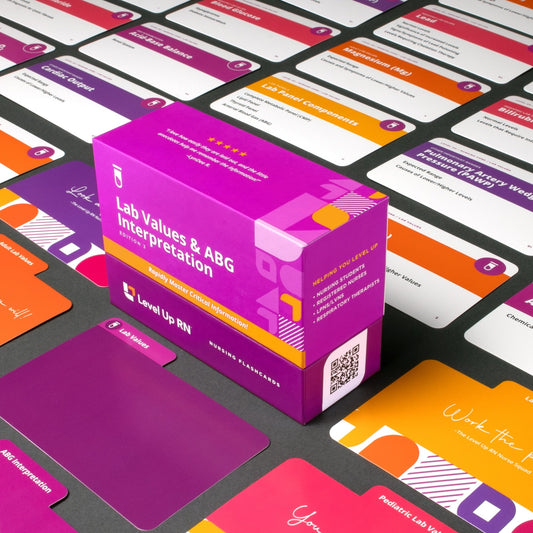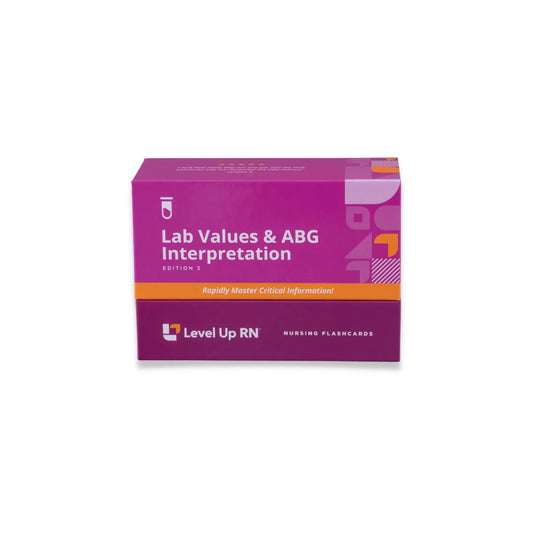Lab Values, part 3: Calcium (Ca)
The function of calcium in the body, the expected range, and possible causes and symptoms of hypocalcemia and hypercalcemia.
Full Transcript: Lab Values, part 3: Calcium (Ca)
Full Transcript: Lab Values, part 3: Calcium (Ca)
Hi, I'm Meris, and in this video, I'm going to be talking to you about the lab value calcium. I'll be talking to you about the expected range and the causes and symptoms of higher or lower values of calcium. I'm going to be following along using our lab values flashcards. These are available on our website, leveluprn.com, if you want to grab a set for yourself. Or if you are more of a fan of digital products, I would invite you to check out Flashables, which is the digital version of all of our flashcards available right now on demand in your pocket wherever you go. All right. Let's go ahead and get started.
So first up, let's just talk about what calcium is and why it matters to the body. So calcium is going to be a very, very important electrolyte for our body when it comes to many physiological functions. Big one here being bone and teeth formation along with nerve and muscle function. But it does have an important role in many different functions in the body. Now, one of the things that it also has a role to do with that I think gets left out of the conversation a lot is clotting. And as a trauma nurse, this is why calcium matters a lot to me, is that it is also an integral part of the clotting cascade in two separate locations. So just remember that calcium, we think about bones and teeth, and it's super important for that. But there are other functions that calcium has as well. And for me, for my purposes, blood clotting is one of them.
Now, let's talk about the expected range for calcium. We have to know what we expect an average human being to fall in when we're talking about these ranges. So for calcium, in particular, we are talking about 9 to 10.5 milligrams per deciliter. 9 to 10.5. And we do have a cool chicken hint here on the card for you to help remind yourself of this value because it can be tricky to remember all of these little values and what their normal ranges are. So we came up with some ways to remember. And our cool chicken hint here is California, CA, is due for a big earthquake, 9 to 10 and a half on the Richter scale. So that's one way that you can remember it. But we actually have two ways. We have two cool chickens here. The other one is to call, CA, call 911. So call 911. It's going to tell you 9 to 11. It's just helping you to remember the general range, but you're going to have to remember that that maximum top number is 10. 5. Again, with any lab value that we are talking about, though, all of these are subject to your textbook, your lab, your facility. Just know that this is what we found as the best general consensus on what these lab values should be.
Now, what happens if I have hypocalcemia? And I'm going to tell you a personal story about myself as we progress through this video because I hope that it will help you to remember. Hypocalcemia, we have low calcium in our blood, meaning we are below 9 milligrams per deciliter. If I have hypocalcemia, some of the causes here could be hypoparathyroidism, acute pancreatitis, and then vitamin D deficiency. If I don't have enough vitamin D, I cannot synthesize whatever calcium I have. I cannot get it where it needs to go. So vitamin D insufficiency can lead to hypocalcemia as well. What are some symptoms, though, of hypocalcemia? Well, the big ones here are going to be a positive Chvostek's and Trousseau's sign, and I'm going to talk to you briefly about these.
Chvostek's sign is where I tap on the facial nerve of my patient on one side or the other. I tap on the facial nerve, and I look to see, is there any twitching on that side? If I tap here and see twitching, that is a positive Chvostek's sign. This is not our official cool chicken hint, but the way I remember the difference between the two is C for Chvostek's. I think C for cheek. Now, Trousseau's sign. Trousseau's sign is very interesting. I've only ever seen it once, but the way that you will observe it is we will put a blood pressure cuff on and inflate that blood pressure cuff. And while it is inflated, you will watch their hand. I'm going to bring it up so you can see. You will watch their hand begin to do this. They will have a carpal spasm, and it gives them kind of this appearance of their limb while the blood pressure cuff is inflated. That is called Trousseau's sign, and that would be a positive finding. That would be an abnormal finding. So both of these are present in hypocalcemia. Super, duper important things to know in relation to one another and in relation to that electrolyte imbalance. So aside from Chvostek's and Trousseau's sign, what else might we be seeing in somebody who has hypocalcemia? Muscle weakness? Absolutely possible. And then paresthesias. Paresthesias are those pins and needles or that burning, prickling sensation. Very common to have it in the fingers and toes, but with hypocalcemia, they can also experience it around the mouth. We call that circumoral paresthesia.
Now, on the flip side, what if I have too much calcium? Well, what are some possible causes of hypercalcemia? Some causes would be the opposite of what causes hypocalcemia. So hypocalcemia goes with hypoparathyroidism. Hypercalcemia goes with hyperparathyroidism. If I have an overactive parathyroid gland, it is going to take all of the calcium out of my bones and dump it into my blood, thereby raising my serum calcium. Okay? Some other possible causes of hypercalcemia, cancer. This is a very big one. Malignancy can lead to elevated calcium. Prolonged immobility. This is hugely important for the NCLEX test-taking world and for your general clinical practice. If I have somebody who is in a state of prolonged immobility, they're not stressing their bones, they're not putting any weight on their bones, their body will say, "I guess they don't need to be so dense," and they'll start to chew up their bones, liberating calcium into the blood, thereby raising your patient's blood calcium. Some other considerations too would be long-term corticosteroid use. This is an important one to know for some other NCLEX things as well.
Now, what are some symptoms that I might see in somebody who has - I'm sorry - hypercalcemia? Here's some symptoms from our list. Kidney stones. Kidney stones is a huge thing for you to consider because if I have too much calcium in my blood, it's going to go to my kidneys. My kidneys are going to filter it out. That calcium is going to start to collect in my kidneys. And then before you know it, you're going to have a kidney full of stones, just like this one that I have back here on my arm. Kidney stones are absolutely a possible outcome of hypercalcemia. GI upset, including constipation, bone pain, muscle weakness, and confusion. Now, I told you I was going to tell you a personal story about me, and this is the story that I always tell to students. This is the story that I tell about the time I almost died from hypercalcemia. So when I was 14, I suffered from hyperparathyroidism. We did not know it at the time. The way that it was diagnosed was due to the findings associated with hypercalcemia. Okay? I was 14 years old. I was way too young to have hyperparathyroidism. This is normally a condition that affects people who are postmenopausal. So this was very unusual for me to have this benign tumor on my parathyroid.
What happened was all of the calcium got leached out of my bones and dumped into my blood, and I had a calcium level that was so high that it could not be read by the laboratory. It only resulted as high. Let me tell you what my symptoms were. My symptoms were very classic stones, bones, psychic moans, GI overtones. So I had bone pain, severe deep pain in my bones, which came from the liberating of the calcium. It is painful to have your bones chewed up by those osteoclasts. I also had severe GI problems, belly pain all the time, constipation. I was incredibly weak. I was exhausted. I slept all of the time. And I had some psychiatric disturbances as well, some things that just caused me to have strange behaviors, strange personality changes. Finally, I was diagnosed because I had a kidney full of stones. And that's why I have this tattoo back here of this kidney full of stones. It's because when I was 14, they found I had something insane in my kidneys, like 21 stones in both of my kidneys. Again, because I had been hypercalcemic for so long. It was identified that I had hyperparathyroidism, which is why I have this scar across my neck here is because I had a parathyroidectomy. I had a removal of my one affected parathyroid gland.
When you take out a parathyroid gland, it takes some time for the others to wake up. So they took it out, and it took time for my other three parathyroid glands to perk up and say, "Oh, we're supposed to be doing something." During that time, my calcium level plummeted because we got rid of the bad parathyroid, and now nothing was happening. So I went from being hypercalcemic to profoundly hypocalcemic. And I knew I needed to go to the hospital when I couldn't control my legs, by which I mean I wanted them to move. I was trying to move them. They were not moving. Muscle weakness, remember? And I had paresthesias around the mouth in particular. I had circumoral paresthesia. I went to the ER. They drew my blood and said, "Yes, absolutely. She's very low on calcium." They remedied the situation, and I felt much better. So when you think of hypercalcemia, I want you to think of me before diagnosis, GI problems, sleep disturbances, bone pain, weakness, just psychiatric disturbances, and kidney stones. And then when you think of hypocalcemia, I want you to think about little 14-year-old me on the couch saying, "Mom, I'm trying to move my feet, but they won't move." I was so profoundly weak and had such significant nerve and muscle dysfunction that I was unable to move my little feet, and I had paresthesias around the mouth.
All right. I'm so glad you stayed until the end, not just so you could hear my story about hyper and hypocalcemia, but because I'm going to test your knowledge of some key facts I provided in this video with my quiz questions.
The nurse is caring for a patient experiencing hyperparathyroidism. Which electrolyte imbalance should the nurse anticipate?
Hypercalcemia.
While caring for a patient, the nurse suspects they may be experiencing hypocalcemia. The nurse taps on the patient's facial nerve, which causes their face to twitch. What has the nurse just observed?
A positive Chvostek's sign.
All right. That is it for this video. I hope you learned something and found it useful. Thanks so much, and I'll see you next time.


